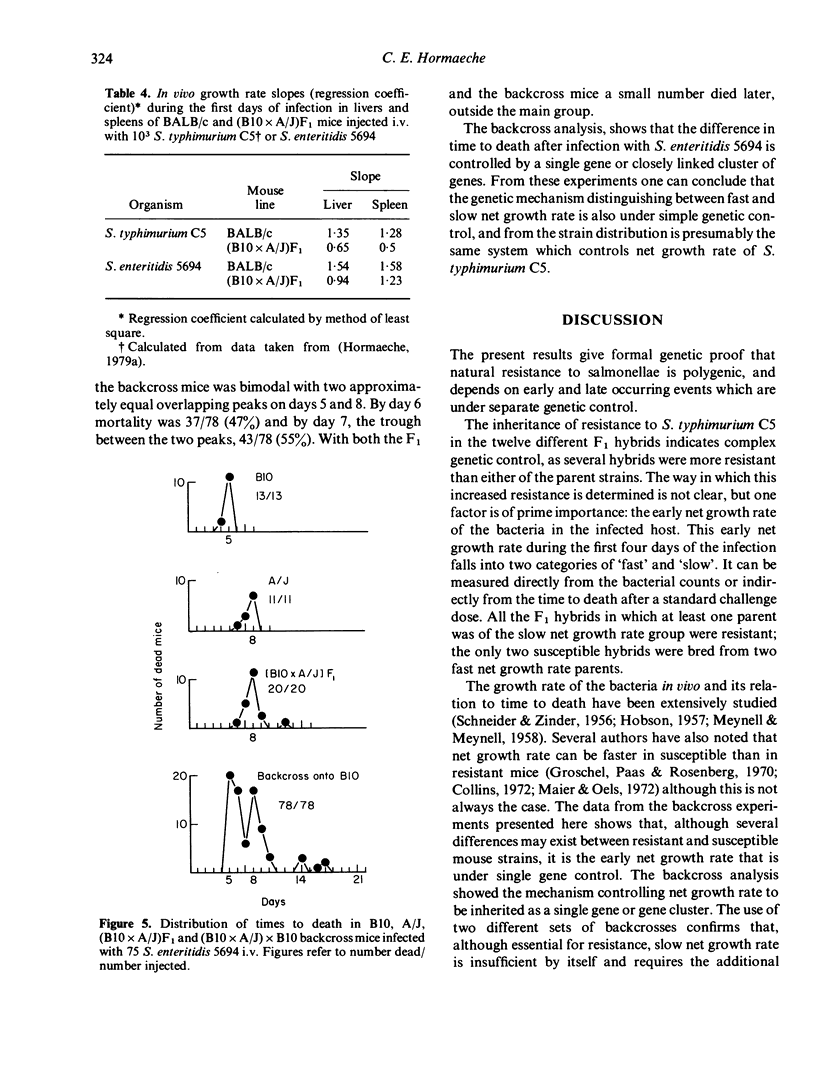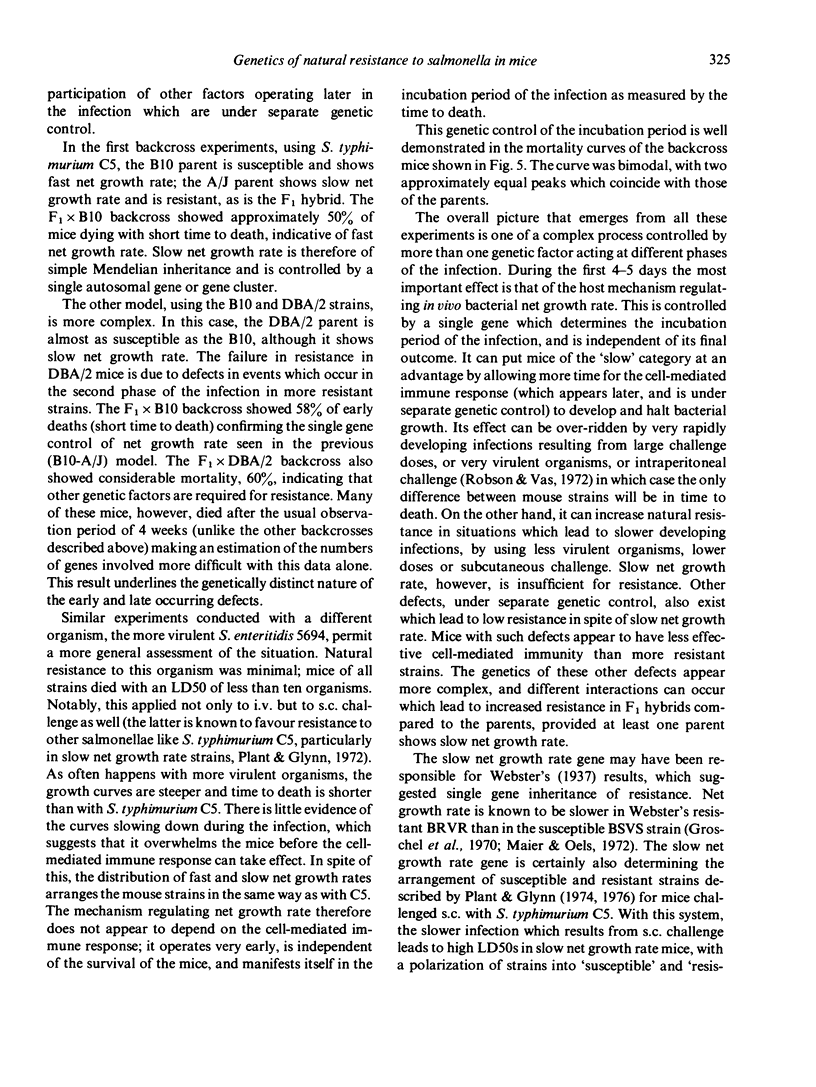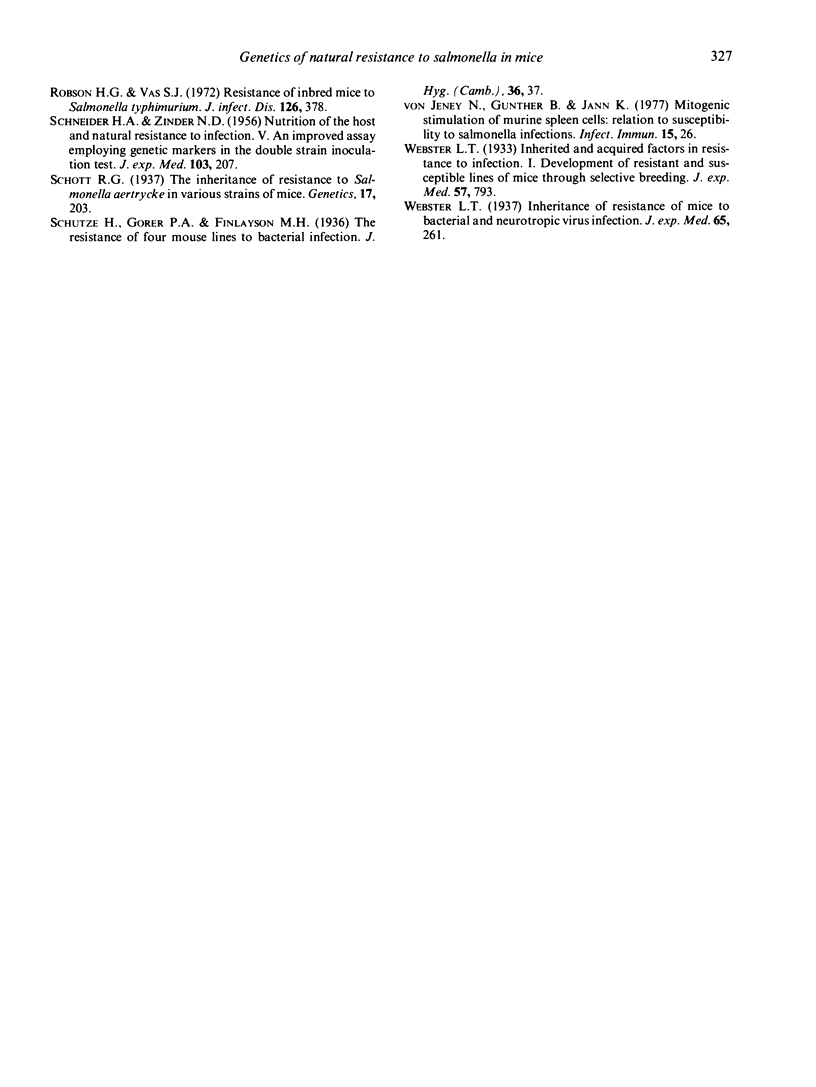Abstract
The genetics of natural resistance to salmonellae were studied in F1 hybrid and backcross mice. Overall resistance to Salmonella typhimurium C5 is complex, but one parameter, the early net growth rate of the organism in vivo, is controlled by a single autosomal gene or cluster of genes. 'Slow' net growth rate is necessary but insufficient, for resistance to S. typhimurium C5. Resistance requires the participation of other mechanisms, detectable by the end of the first week, which presumably involve an immune response. F1 hybrids bred from parents of low, intermediate and high natural resistance showed either high or low resistance. Most of the F1 hybrids were of a similar high resistance, and were bred from pairs in which at least one parent showed slow net growth rate. Hybrids of low resistance were only obtained when neither parent showed slow net growth rate. No hybrid was less resistant than the parents, many were more resistant. Backcross analysis on two hybrids challenged with S. typhimurium C5 supports the hypothesis of complex genetic control of overall resistance but with single gene control of the early net growth rate of the organism. Similar experiments were performed using a much more virulent organism, S. enteritidis 5694. All mouse strains were very susceptible (LD 50 less than ten organisms) to this strain given either i.v. or s.c. This organism produced an overwhelming infection which did not allow the cell-mediated immune response time to develop. This, however, did not interfere with the mechanism controlling early net growth rate, and genetic analysis using this organism gave similar results to those obtained with S. typhimurium C5. These results suggest that the mechanism regulating early net growth rate does not operate via the cell-mediated immune response, which develops later in the course of the infection.
Full text
PDF








Selected References
These references are in PubMed. This may not be the complete list of references from this article.
- Bradley D. J., Kirkley J. Regulation of Leishmania populations within the host. I. the variable course of Leishmania donovani infections in mice. Clin Exp Immunol. 1977 Oct;30(1):119–129. [PMC free article] [PubMed] [Google Scholar]
- Bradley D. J. Letter: Genetic control of natural resistance to Leishmania donovani. Nature. 1974 Jul 26;250(464):353–354. doi: 10.1038/250353a0. [DOI] [PubMed] [Google Scholar]
- Bradley D. J. Regulation of Leishmania populations within the host. II. genetic control of acute susceptibility of mice to Leishmania donovani infection. Clin Exp Immunol. 1977 Oct;30(1):130–140. [PMC free article] [PubMed] [Google Scholar]
- Collins F. M., Mackaness G. B. Delayed hypersensitivity and arthus reactivity in relation to host resistance in salmonella-infected mice. J Immunol. 1968 Nov;101(5):830–845. [PubMed] [Google Scholar]
- Collins F. M. Salmonellosis in orally infected specific pathogen-free C57B1 mice. Infect Immun. 1972 Feb;5(2):191–198. doi: 10.1128/iai.5.2.191-198.1972. [DOI] [PMC free article] [PubMed] [Google Scholar]
- Collins F. M. Vaccines and cell-mediated immunity. Bacteriol Rev. 1974 Dec;38(4):371–402. doi: 10.1128/br.38.4.371-402.1974. [DOI] [PMC free article] [PubMed] [Google Scholar]
- GOWEN J. W. Genetic effects in nonspecific resistance to infectious disease. Bacteriol Rev. 1960 Mar;24(1):192–200. doi: 10.1128/br.24.1.192-200.1960. [DOI] [PMC free article] [PubMed] [Google Scholar]
- MEYNELL G. G., MEYNELL E. W. The growth of micro-organisms in vivo with particular reference to the relation between dose and latent period. J Hyg (Lond) 1958 Sep;56(3):323–346. doi: 10.1017/s0022172400037827. [DOI] [PMC free article] [PubMed] [Google Scholar]
- Maier T., Oels H. C. Role of the macrophage in natural resistance to salmonellosis in mice. Infect Immun. 1972 Oct;6(4):438–443. doi: 10.1128/iai.6.4.438-443.1972. [DOI] [PMC free article] [PubMed] [Google Scholar]
- Maw J., Meynell G. G. The true division and death rates of Salmonella typhimurium in the mouse spleen determined with superinfecting phage P22. Br J Exp Pathol. 1968 Dec;49(6):597–613. [PMC free article] [PubMed] [Google Scholar]
- Medina S., Vas S. I., Robson H. G. Effect of nonspecific stimulation on the defense mechanisms of inbred mice. J Immunol. 1975 Jun;114(6):1720–1725. [PubMed] [Google Scholar]
- Misfeldt M. L., Johnson W. Variability of protection in inbred mice induced by a ribosomal vaccine prepared from Salmonella typhimurium. Infect Immun. 1976 Sep;14(3):652–659. doi: 10.1128/iai.14.3.652-659.1976. [DOI] [PMC free article] [PubMed] [Google Scholar]
- Plant J., Glynn A. A. Natural resistance to Salmonella infection, delayed hypersensitivity and Ir genes in different strains of mice. Nature. 1974 Mar 22;248(446):345–347. doi: 10.1038/248345a0. [DOI] [PubMed] [Google Scholar]
- Robson H. G., Vas S. I. Resistance of inbred mice to Salmonella typhimurium. J Infect Dis. 1972 Oct;126(4):378–386. doi: 10.1093/infdis/126.4.378. [DOI] [PubMed] [Google Scholar]
- SCHNEIDER H. A., ZINDER N. D. Nutrition of the host and natural resistance to infection. V. An improved assay employing genetic markers in the double strain inoculation test. J Exp Med. 1956 Feb 1;103(2):207–223. doi: 10.1084/jem.103.2.207. [DOI] [PMC free article] [PubMed] [Google Scholar]
- Schott R G. The Inheritance of Resistance to SALMONELLA AERTRYCKE in Various Strains of Mice. Genetics. 1932 Mar;17(2):203–229. doi: 10.1093/genetics/17.2.203. [DOI] [PMC free article] [PubMed] [Google Scholar]
- von Jeney N., Günther E., Jann K. Mitogenic stimulation of murine spleen cells: relation to susceptibility to Salmonella infection. Infect Immun. 1977 Jan;15(1):26–33. doi: 10.1128/iai.15.1.26-33.1977. [DOI] [PMC free article] [PubMed] [Google Scholar]


